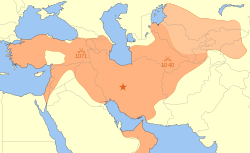ผลต่างระหว่างรุ่นของ "จักรวรรดิเซลจุค"
เนื้อหาที่ลบ เนื้อหาที่เพิ่ม
ล เก็บกวาดแม่แบบเรียงลำดับ |
ลิงก์ข้ามภาษาได้ย้ายไปยังวิกิสนเทศที่ d:Q3708094 โดยอัตโนมัติ |
||
| บรรทัด 77: | บรรทัด 77: | ||
[[kk:Салжұқтар]] |
[[kk:Салжұқтар]] |
||
[[ku:Selçûqî]] |
[[ku:Selçûqî]] |
||
[[ky:Селжуктар мамлекети]] |
|||
[[la:Selgiukidae]] |
[[la:Selgiukidae]] |
||
[[lt:Seldžiukai]] |
[[lt:Seldžiukai]] |
||
รุ่นแก้ไขเมื่อ 11:09, 4 ตุลาคม 2556
มหาจักรวรรดิเซลจุค شاهنشاهی بزرگ سلجوقی Shahanshahie Bozorge Saljugh | |
|---|---|
| ค.ศ. 1037–ค.ศ. 1194 | |
 จักรวรรดิเซลจุคอันยิ่งใหญ่ในสมัยที่รุ่งเรืองที่สุดในปี ค.ศ. 1092 เมื่อสุลต่านมาลิค ชาห์ที่ 1เสียชีวิต | |
| เมืองหลวง | นิชาเพอร์ เรย์ |
| สุลต่าน | |
• ค.ศ. 1037 - 1063 | Tuğrul Beg (คนแรก) |
• ค.ศ. 1118 - 1153 | Ahmed Sanjar (สุดท้าย) |
| ประวัติศาสตร์ | |
• Tugrul Beg ก่อตั้งเป็นรัฐ | ค.ศ. 1037 |
• มาแทนด้วยจักรวรรดิ Khwarezmian[1] | ค.ศ. 1194 ค.ศ. 1194 |
| ประวัติศาสตร์อิหร่านแผ่นดินใหญ่ | ||||||||||||||||||||||||||||||||||||||||||||||||||||
|---|---|---|---|---|---|---|---|---|---|---|---|---|---|---|---|---|---|---|---|---|---|---|---|---|---|---|---|---|---|---|---|---|---|---|---|---|---|---|---|---|---|---|---|---|---|---|---|---|---|---|---|---|
 | ||||||||||||||||||||||||||||||||||||||||||||||||||||
| กษัตริย์แห่งเปอร์เชีย | ||||||||||||||||||||||||||||||||||||||||||||||||||||
| ก่อนยุคใหม่ | ||||||||||||||||||||||||||||||||||||||||||||||||||||
|
ก่อน อิสลาม
| ||||||||||||||||||||||||||||||||||||||||||||||||||||
|
หลัง อิสลาม
| ||||||||||||||||||||||||||||||||||||||||||||||||||||
|
ยุคใหม่
| ||||||||||||||||||||||||||||||||||||||||||||||||||||
| ||||||||||||||||||||||||||||||||||||||||||||||||||||
| ||||||||||||||||||||||||||||||||||||||||||||||||||||
| ||||||||||||||||||||||||||||||||||||||||||||||||||||
| ||||||||||||||||||||||||||||||||||||||||||||||||||||
| ||||||||||||||||||||||||||||||||||||||||||||||||||||
| ||||||||||||||||||||||||||||||||||||||||||||||||||||
| ||||||||||||||||||||||||||||||||||||||||||||||||||||
มหาจักรวรรดิเซลจุค (เปอร์เซีย: سلجوقیان) เป็นจักรวรรดิแบบเปอร์เชีย[2][3][4][5] ของยุคกลางของซุนนีมุสลิมของชนเซลจุคเตอร์กของเทอร์โค-เปอร์เชีย[6] ที่ก่อตั้งโดยสาขา Qynyq ของ เทอร์โคมัน[7] ที่มีอำนาจครอบครองอาณาบริเวณอันกว้างใหญ่ตั้งแต่เทือกเขาฮินดูกูช ไปถึงทางตะวันออกของอนาโตเลียและจากทวีปเอเชียกลางไปจนถึงอ่าวเปอร์เชีย เซลจุคตั้งต้นมาจากดินแดนบ้านเกิดใกล้ทะเลอาราล และขยายอำนาจไปยังเกรตเตอร์โคราซาน และต่อไปยังเกรตเตอร์อิหร่านก่อนจะไปสิ้นสุดลงที่ทางตะวันออกของอนาโตเลีย
อ้างอิง
- ↑ Grousset, Rene, The Empire of the Steppes, (New Brunswick:Rutgers University Press, 1988),159,161.
- ↑ M.A. Amir-Moezzi, "Shahrbanu", Encyclopaedia Iranica, Online Edition, (LINK): "... here one might bear in mind that non-Persian dynasties such as the Ghaznavids, Saljuqs and Ilkhanids were rapidly to adopt the Persian language and have their origins traced back to the ancient kings of Persia rather than to Turkish heroes or Muslim saints ..."
- ↑ Josef W. Meri, "Medieval Islamic Civilization: An Encyclopedia", Routledge, 2005, p. 399
- ↑ Michael Mandelbaum, "Central Asia and the World", Council on Foreign Relations (May 1994), p. 79
- ↑ Jonathan Dewald, "Europe 1450 to 1789: Encyclopedia of the Early Modern World", Charles Scribner's Sons, 2004, p. 24: "Turcoman armies coming from the East had driven the Byzantines out of much of Asia Minor and established the Persianized sultanate of the Seljuks."
- ↑ Possessors and possessed: museums, archaeology, and the visualization of history in the late Ottoman Empire; By Wendy M. K. Shaw; Published by University of California Press, 2003, ISBN 0520233352, 9780520233355; p. 5.
- ↑
- Jackson, P. (2002). Review: The History of the Seljuq Turks: The History of the Seljuq Turks.Journal of Islamic Studies 2002 13(1):75-76; doi:10.1093/jis/13.1.75.Oxford Centre for Islamic Studies.
- Bosworth, C. E. (2001). Notes on Some Turkish Names in Abu 'l-Fadl Bayhaqi's Tarikh-i Mas'udi. Oriens, Vol. 36, 2001 (2001), pp. 299-313.
- Dani, A. H., Masson, V. M. (Eds), Asimova, M. S. (Eds), Litvinsky, B. A. (Eds), Boaworth, C. E. (Eds). (1999). History of Civilizations of Central Asia. Motilal Banarsidass Publishers (Pvt. Ltd).
- Hancock, I. (2006). ON ROMANI ORIGINS AND IDENTITY. The Romani Archives and Documentation Center. The University of Texas at Austin.
- Asimov, M. S., Bosworth, C. E. (eds.). (1998). History of Civilizations of Central Asia, Vol. IV: The Age of Achievement: AD 750 to the End of the Fifteenth Century, Part One: The Historical, Social and Economic Setting. Multiple History Series. Paris: UNESCO Publishing.
- Dani, A. H., Masson, V. M. (Eds), Asimova, M. S. (Eds), Litvinsky, B. A. (Eds), Boaworth, C. E. (Eds). (1999). History of Civilizations of Central Asia. Motilal Banarsidass Publishers (Pvt. Ltd).
